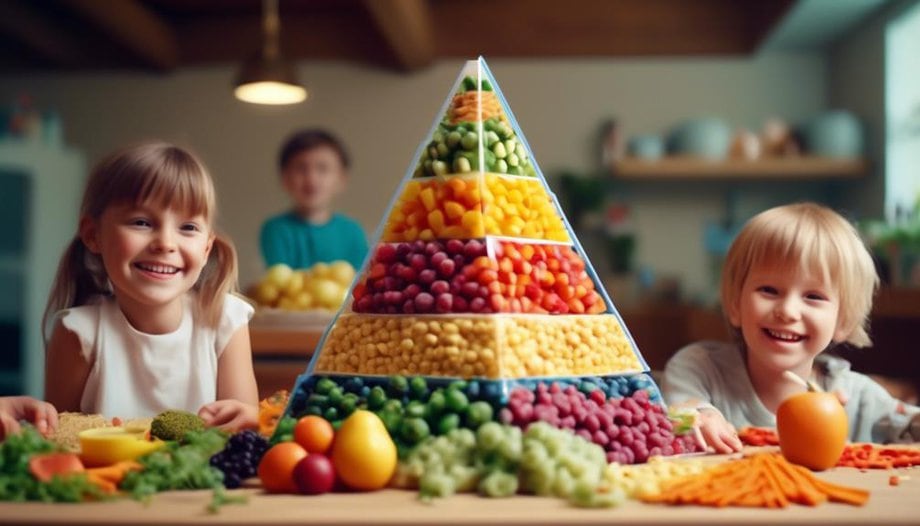How to Simplify Nutritional Concepts for Easy Understanding by Kids

There are several strategies that can be used to simplify nutritional concepts for kids and make them engaging.
First, it is important to break down complex information into simple and relatable terms. Using age-appropriate language and examples that children can relate to will help them understand the importance of healthy eating. For example, explaining that fruits and vegetables are like superpowers for their bodies because they make them strong and help them fight off germs.
Second, incorporating hands-on activities and interactive games can make learning about nutrition fun and engaging. For instance, organizing a "Build Your Own Healthy Plate" activity where children can choose and arrange different food items on a plate to create a balanced meal. This allows them to see visually how different food groups contribute to a healthy diet.
Third, involving children in the meal planning and preparation process can also help them understand the importance of healthy eating. Allowing them to choose a new fruit or vegetable to try each week or helping them prepare a simple recipe can make them more excited about trying new foods and understanding why they are good for their bodies.
Lastly, using visual aids such as colorful charts, posters, or flashcards can reinforce key nutritional concepts. These visual aids can be displayed in the classroom or at home to serve as a constant reminder of healthy eating habits.
Overall, by simplifying nutritional concepts, making them engaging, and ensuring children understand the importance of healthy eating, we can help them develop lifelong habits that will benefit their overall health and well-being.
Importance of Teaching Nutrition to Kids
Teaching kids about nutrition is essential for their overall health and well-being. It empowers them to make informed food choices and develop healthy eating habits. By understanding the importance of healthy eating habits, children are better equipped to take care of their bodies and maintain a balanced diet.
When we teach children about different kinds of foods, we give them the tools to make wise choices and nourish their bodies effectively.
It is important to teach children to eat as little processed and sugary foods as possible. These types of foods may taste good, but they often lack the essential nutrients that growing bodies need. Encouraging children to try new and nutritious foods can be a fun and exciting adventure. By introducing a variety of fruits, vegetables, whole grains, and lean proteins, we can broaden their palates and expand their understanding of what constitutes a healthy meal.
Teach your child by example. Model healthy eating habits and show them the importance of making nutritious choices. Keep it simple and explain why certain foods are beneficial for their bodies.
Making Healthy Eating Fun for Kids
Making healthy eating fun for kids can be as simple as turning it into an exciting adventure. When it comes to introducing new foods to children, it's important to engage their senses and make the experience enjoyable.
Start by discussing the vibrant colors, enticing smells, interesting textures, and delicious tastes of different fruits and vegetables. Encourage your kids to explore and try new foods by sharing fascinating facts about them. Did you know that carrots aren't only crunchy but also great for your eyes? Or that strawberries aren't only sweet but also packed with vitamin C?
By making food education interactive and positive, you can instill a love for healthy eating in your children. Encourage them to think about the types of foods they're eating and how it nourishes their bodies. You can even involve them in meal planning and preparation, allowing them to choose and help prepare nutritious meals.
Make it a fun family activity by creating themed meals or turning mealtime into a game. Remember, healthy eating doesn't have to be boring. With a little creativity and enthusiasm, you can make it a delightful experience for your kids.
Using Everyday Examples to Explain Nutrition
To help children understand the importance of nutrition, it's helpful to use everyday examples that relate to their own experiences and activities. One way to do this is by using colorful and relatable examples to explain the benefits of different food groups. You can relate the importance of balanced meals to everyday activities, like fueling up for sports or having energy for playtime. For example, you can explain that just like a car needs the right kind of fuel to run smoothly, our bodies need the right kind of fuel, which comes from eating a variety of healthy foods.
Another way to simplify nutrition concepts is by using familiar objects to explain portion control. You can use a deck of cards to represent a serving of meat or a tennis ball to represent a serving of fruit. This helps children understand how much of each food group they should be eating.
You can also use storytelling or role-playing to illustrate the effects of different foods on the body. For instance, you can explain how protein helps muscles grow strong by pretending to be a superhero with strong muscles after eating a protein-packed meal.
Simplifying Food Labels for Kids
Are you ready to help your kids understand food labels? Let's make it simple and easy to understand.
By teaching kids to focus on the ingredients and nutritional information, they can make healthier choices. Encourage them to look for foods with less added sugar and sodium, and to understand serving sizes and daily values.
Kid-Friendly Food Labels
When it comes to understanding what's in your food, learning to read food labels is an important skill that can help you make healthier choices. Kid-friendly food labels are designed to make it easier for children to understand the nutritional content of the food they eat. These labels often use simple language and visuals to convey information. Take a look at the table below to see an example of a kid-friendly food label:
| Food | Serving Size | Calories | Sugar (g) | Sodium (mg) |
|---|---|---|---|---|
| Apple | 1 medium | 95 | 19 | 0 |
| Potato Chips | 1 oz (about 15 chips) | 152 | 0 | 170 |
| Carrots | 1 medium | 25 | 6 | 42 |
As you can see, the table provides information about the serving size, calories, sugar, and sodium content of each food. This can help you make informed choices about what you eat. Remember, it's important to choose a variety of healthy foods like fresh fruits and vegetables that provide essential vitamins and minerals. By reading food labels, you can avoid unhealthy eating habits and make better choices for your overall health and well-being.
Understanding Nutrition Facts
Understanding nutrition facts can be made easier for kids with simplified food labels. When kids learn how to read and understand food labels, they can make healthier choices and develop good eating habits. Here are some key points to help kids understand nutrition facts:
- Certain foods: Teach kids about the different food groups and the importance of eating a balanced diet.
- Vitamin D: Explain the role of vitamin D in supporting healthy bones and how to find it in foods like milk and fortified cereals.
- Childhood obesity: Discuss the risks of consuming too many empty calories and the importance of portion control.
- Added sugar: Teach kids to look out for added sugars in their food and drinks, as excessive consumption can lead to health problems.
Engaging Activities to Teach Kids About Nutrition
Are you looking for fun and interactive ways to teach your kids about nutrition? Look no further!
Engaging activities can make learning about healthy eating enjoyable and memorable for children. From creating colorful fruit and vegetable art to organizing cooking classes and taste-testing sessions, there are plenty of exciting options to explore.
Let's delve into the world of fun food games and healthy recipe crafts to engage your kids in the wonderful world of nutrition!
Fun Food Games
Get ready to embark on a fun-filled food adventure with engaging activities that will teach kids about nutrition! Here are some exciting food games to help children learn about the importance of healthy eating:
- Food Fact Challenge: Share interesting facts about specific foods and challenge kids to guess which ones are good for them. This game sparks curiosity and encourages learning.
- The Healthy Plate Game: Teach kids about balanced meals by letting them create their own plates with different food groups. This activity helps them understand the importance of eating a variety of foods.
- Cooking Together: Involve younger kids in the kitchen and let them help with meal preparation. This hands-on experience teaches them about different ingredients and how to make healthy choices.
- Picky Eater Challenge: Turn trying new foods into a game by creating a challenge where kids earn points for trying new fruits, vegetables, or other healthy options. This game encourages them to be adventurous eaters.
Healthy Recipe Crafts
Embark on a creative and educational journey as we dive into the world of 'Healthy Recipe Crafts' – engaging activities that will teach kids about nutrition while having fun! By incorporating different foods into crafts, you can make sure that kids are not only learning about healthy eating but also enjoying the process. Family Health is important, and getting kids excited about nutritious food is a great way to promote their well-being. Take a look at the table below for some ideas on healthy recipe crafts that you can try with your little ones:
| Craft Idea | Ingredients | Benefits |
|---|---|---|
| Fruit Kabob | Assorted fruits | Encourages kids to eat more fruits |
| Veggie Pizza Faces | Whole wheat pita, vegetables | Promotes creativity and introduces new veggies |
| Yogurt Parfait | Yogurt, granola, berries | Teaches kids about balanced snacks and portion control |
| Rainbow Salad | Assorted vegetables | Introduces different colors and textures of veggies |
| Smoothie Popsicles | Fresh fruits, yogurt | Provides a healthy and refreshing treat |
Encouraging Kids to Make Healthy Food Choices
To encourage kids to make healthy food choices, it's important to create a positive and open environment for discussing nutrition. Here are some tips to help you guide your child towards making healthier choices:
- Avoid negative labeling of foods – Instead of categorizing foods as 'good' or 'bad,' focus on teaching the importance of moderation and balanced food choices. Let your child know that all foods can be enjoyed in moderation.
- Involve your child in food-related decisions – Bring your child along for grocery shopping, involve them in meal planning, and let them help with meal preparation. By including them in these activities, they'll feel a sense of ownership over their diet and be more likely to make healthier choices.
- Be a role model – Children learn by watching their parents, so make sure to model healthy eating habits yourself. Show them that you enjoy nutritious foods and involve them in meal planning and cooking.
- Provide age-appropriate information – As children get older, their nutritional needs change. Adapt your nutrition education to match their age and provide them with age-appropriate information about healthy eating. This will help them understand the importance of making nutritious choices as they grow.
Tips for Creating a Nutritious Family Meal Plan
When it comes to creating a nutritious family meal plan, there are several practical strategies you can implement to ensure that your family is eating well and enjoying delicious, wholesome meals together.
One important tip is to involve your kids in grocery shopping and meal preparation. This allows them to take ownership of their diet and encourages them to make healthier food choices.
Another tip is to model healthy eating habits by choosing whole grains, lean proteins, and limiting sugary drinks. By doing so, you're setting a good example for your children and promoting a balanced diet.
Creating a regular mealtime routine is also crucial in establishing healthy eating habits and fostering family connection. Eating together as a family not only provides an opportunity for bonding but also encourages mindful eating.
During mealtime, it's important to teach children about the importance of balanced nutrition without labeling foods as 'good' or 'bad'. Instead, focus on the benefits of each food group and how they contribute to overall well-being.
When planning your family meals, aim for a variety of fruits and vegetables, including apples and bananas, which are rich in vitamins and minerals. Incorporate dairy products like milk for calcium and protein. Opt for cooking methods that use olive oil instead of unhealthy fats.
It's also important to consider any specific health conditions or dietary restrictions your family members may have.
Frequently Asked Questions
What Are the Basic Concepts of Nutrition for Children?
To understand nutrition, you need to know the importance of a balanced diet, essential nutrients for growth, benefits of food groups, healthy snacking options, portion sizes, hydration's role, smart food choices, and the impact of unhealthy eating habits.
How Do You Explain Basic Nutrition Concepts?
To explain basic nutrition concepts, you can start by emphasizing the importance of a balanced diet. Teach about food groups and their benefits, nutrients and their functions, portion control, reading food labels, making healthy choices, and the effects of unhealthy habits. Don't forget to highlight the benefits of drinking water.
How Do You Teach Kids About Nutrition?
To teach kids about nutrition, it's important to emphasize the benefits of a balanced diet, including the importance of food groups, vitamins, and minerals. Teach about healthy snacks, portion sizes, reading labels, staying hydrated, and making smart choices at school or parties.
How Do You Teach Nutrition in a Fun Way?
To teach nutrition in a fun way, engage kids with healthy eating games, cooking with nutritious ingredients, food group scavenger hunts, and creating balanced plates. Make nutritious snacks, read food books, role play as nutrition superheroes, and do garden to table activities.











